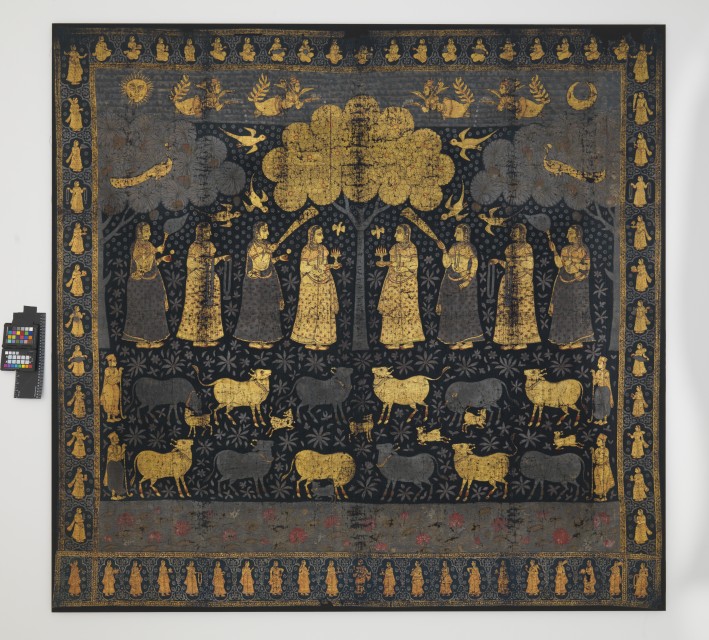
The Rainy Season (Varsha)

Photography by Bruce White, Digital image © Asia Society
The Rainy Season (Varsha)
Late 17th century
India, Gujarat or the Deccan
Opaque watercolor, gold, and silver on dyed cotton
H. 80 3/4 x W. 86 1/2 in. (205.1 x 219.7 cm)
Asia Society, New York: Mr. and Mrs. John D. Rockefeller 3rd Collection, 1979.59
Provenance
John D. Rockefeller 3rd, New York, NY; acquired from The Heeramaneck Gallery, New York, NY, 1960.
The Asia Society, New York, NY, bequest of John D. Rockefeller 3rd, 1979.
Licensing inquiries
Large temple hangings known as pichhavais ("those which hang at the back") were intended to be hung behind sculptures of Krishna and are usually painted with images of Krishna or with scenes from his life. The eight women flanking a flowering tree represent a popular theme in Indian literature and art: the cowherdesses (gopis) with whom Krishna is often shown playing with or hiding from. Such is the god's power that each cowherdess and indeed every woman he encounters believes that she is the only one whom Krishna loves. This theme is generally interpreted as a metaphor for the soul's longing for union with the divine. The women in this painting are depicted holding objects such as peacock feathers, fly whisks, and garlands that would have been offered to the statue of Krishna. This pichhavi represents Varsha, the rainy season, as indicated by the darkened band of thunder clouds at the top. The eight gopis stand facing inwards at two groups of four, in attendance on Krishna who is not depicted but whose image would have stood on an altar in front of the hanging. Peacocks perch in the outer two trees and a number of smaller birds in flight enliven the otherwise rather static composition. Tended by gopas (cowherds), two rows of cows with calves stand below the gopis. The river Jumna with fish, turtles, crabs, and other water creatures swimming among lotuses is shown at the bottom, recalling Krishna's birth place, the village of Gokul on the Jumna River opposite the city of Mathura. The sun and the moon are both visible in the thunder clouds at the top and divinities in baggy pantaloons on either side witness the scene and rain down flowers which diaper the background. Gopis bearing offerings appear within medallions around the border. The pichhavi was constructed of four large, vertical panels of cotton of equal size, and the seams are clearly visible. Although there is some abrasion of the pigment along the seams from folding -- for storage in chests when not in use -- the hanging is in remarkably good condition.

